
views
TikTok has decided to retaliate, in light of a potential ban in USA – now its most popular market for users outside of its home country, China. The Bytedance owned company announced yesterday that it has been left with “no choice” but to sue the Donald Trump-led USA government in light of the US president’s decision to impose a complete ban on TikTok, if it doesn’t sell its American operations over to an American company. Now, TikTok has revealed its user numbers in both American and global markets for the first time, officially – showing its striking rise to popularity, and how big a threat does it represent to the all-encompassing market dominance of Facebook and its services.
Back in January 2018, exactly 2.5 years (or 10 quarters) ago, TikTok reportedly had 55 million monthly active users (MAUs) across the world, 11 million of which were from USA. In comparison, the Facebook group’s overall MAU count was already a staggering 2.13 billion around the world. In essence, Bytedance’s TikTok was only 2.6 percent Facebook’s size, with the latter’s might including Instagram, Messenger, WhatsApp and Facebook itself – four apps that are at the top of all app download charts and user/engagement statistics around the world.
TikTok’s filing at a US court has now revealed that as of July 2020, TikTok has clocked up a staggering growth of 1,152.7 percent – largely thanks to its rapid, viral expansion in India, where it has been banned since June 29, 2020. TikTok’s global MAU numbers shot up to about 689 million, according to the company’s filings. In comparison, Facebook’s latest user numbers are reportedly at 2.7 billion, as per the company’s latest earnings report. The Facebook group has hence grown at 26.9 percent over the past two and a half years – which is quite impressive given the sheer size of Facebook’s user base.
However, one very interesting statistic here reads that while TikTok had only 2.6 percent of Facebook’s user base back in January 2018, its global MAUs today stand at 25.5 percent of all Facebook users – a full quarter of Facebook’s mighty standing in the social media industry. It is this that lends perspective at TikTok’s phenomenal growth pace, and how a ban in USA may change all of that. TikTok has already faced a significant setback in India, which overshadowed USA as TikTok’s biggest overseas market prior to the ban. While TikTok did not offer any official data prior to or after its India ban, data from Business of Apps claims that TikTok was downloaded 323 million times in India in 2019 – a whopping 43.8 percent of its global download numbers.
While Facebook is still comfortably overshadowing TikTok in terms of overall numbers, publicly paranoid chief executive Mark Zuckerberg will have likely taken note of this already. Facebook has acknowledged TikTok has a major rival already in public, and right in line with TikTok’s privacy-ridden troubles around the world, Facebook (via Instagram) launched Reels – a short video format that clones TikTok’s user experience. Given the existing user base that Instagram and the rest of Facebook group already has, Zuckerberg appears to have taken note of the wind of caution, which TikTok has now officially confirmed through its court filings.
Reports have speculated on a wide variety of outcomes that Donald Trump’s war against TikTok may lead to – eventual ban on TikTok, sale to Microsoft (or maybe even Twitter or Oracle), and now, a lawsuit filed by the Chinese social media app that promises to be a messy and protracted legal affair. TikTok has constantly claimed that it does not have privacy issues the way it has been portrayed, and claimed yesterday that the company has tried taking “extraordinary measures” to address the US government’s concerns.
Given its meteoric growth in the past two years, it is hardly a surprise that they are taking such measures to keep themselves operating globally – failing to do which might push it into a China centric niche that Huawei is being pushed into.




















Comments
0 comment